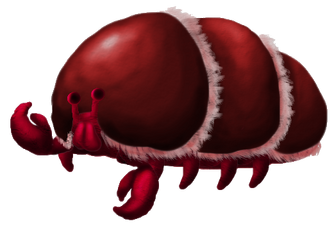Summary[]

A male Hrum-va
These crab-like beasts cover all of Khorrum, being the most prolific and common animal in the area. They average in size of a normal cow and are similar in temperament, as well as being herbivores most of the time; though they'll scavenge bones when they can. Because their stomach is so large, they often swallow stones to aid in digestion; the rocks crush food during peristalsis. The Mhenuur tame females to use as livestock, using their milk, meat, and eggs as food. Hrum-va farms are common in Mhenuur settlements and are their main source of protein in the Mhenuur diet. Males are commonly used for breeding, but wild ones are often hunted for sport, but some disreputable hunters capture them and use them for bloodsports. It is, however, considered unnatural (unlawful) and the Shaman Order sentences anyone found dealing in it with exile or death. In Wurxith society, Hrum-va are occasionally captured to be used in their bloodsports.
Physiology[]
Hrum-va are protected by three large shell plates that cover most of their body. Alone the underside of each plate is a lining of pinkish-whit, down-like (feathery) capillary tufts that act as a secondary circulation system. Excess blood supply is exchanged into these capillaries by way of strong valves that keep the other supply in the primary circulation system while the secondary supply is sent out to the outer capillaries to radiate heat outward; this causes the 'tufts' to turn bright red with blood. The blood, now cooled, is returned to the internal circulatory system and the other blood supply takes its place in the outer system. Males have much larger capillary 'tufts' and these often turn red in an instant if they are angered, startled, or trying to intimidated rivals or predators. Their large claws are used for fighting and chasing away predators like the Ghorrim or Brukk'da from their mates. Females lack the large claws of the males and while they have shorter 'tufts', they have eight orifices on each side that lactate a bluish-white milky substance that drips down the lower 'tufts'; the capillaries warm the milk for their young to drink. Females tend to be more docile then males unless their young are threatened. More females are born than males and adult males often take harems of females, fending off rivals and predators alike.
